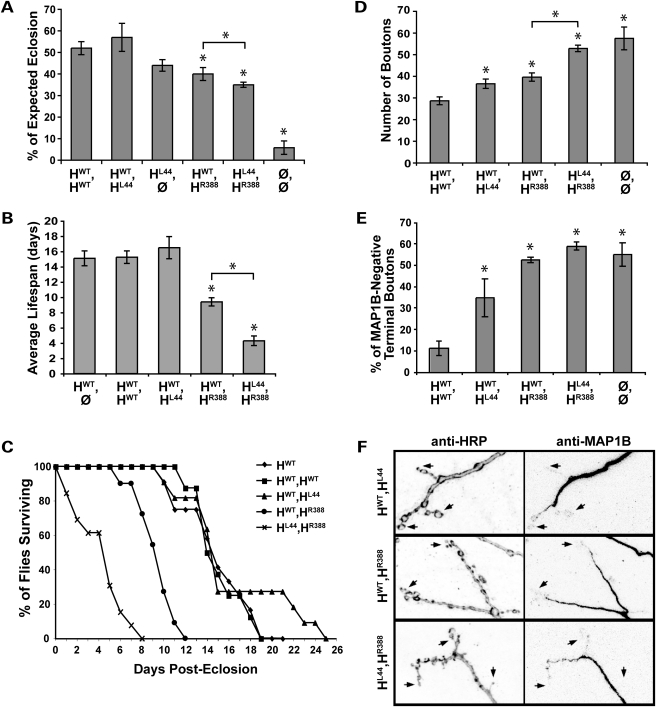Figure 4.
The amino-terminus S44L mutation exacerbates R388 catalytic domain mutant phenotypes but is itself only mildly deleterious. (A) L44 expressed heterozygously (HWT,HL44) or alone (HL44,Ø) rescues eclosion as effectively as one or two copies of the wild-type transgene, HWT (P > 0.1). Co-expression of R388 and L44 slightly but significantly lowers eclosion compared with the HWT,HR388 genotype, consistent with L44 being largely silent in combination with wild-type Spastin, but deleterious when in trans with a catalytic domain mutant in Spastin (P < 0.02). (B, C) Post-eclosion, survival of adult flies is dramatically affected by Spastin genotype. Compared with controls, HWT,HR388 heterozygotes survive on average only about half as long, and HL44,HR388 compound heterozygotes survive less than half as well as those (P < 9 × 10−6). No deleterious effect of the L44 allele is seen in HWT,HL44 heterozygotes compared with wild-type, however. (D, E) HWT,HL44 larvae show moderate but significant increases in bouton number and the percentage of terminal boutons lacking MAP1B compared with HWT,HWT controls, indicating that L44 is somewhat deleterious at the cellular level (P < 0.01 for both parameters). When in trans with R388, however, L44 strongly enhances the R388 loss of function phenotype, to levels equivalent to spastin nulls (P > 0.3). Bouton number is significantly greater in the compound versus single mutants (P < 6 × 10−7), although both genotypes are deficient in terminal bouton microtubules, similar to nulls. (F) Representative synaptic bouton arbors with their MAP1B-positive microtubule distribution are shown for the different ‘AD-HSP’ genotypes. Presynaptic arbors in HWT,HL44 animals resemble wild-type, with large, round terminal boutons (e.g. arrows) sometimes penetrated by microtubules. HWT,HR388 larvae exhibit smaller, more clustered boutons often devoid of microtubule staining, and HL44,HR388 synapses are similarly, but much more severely, affected.

